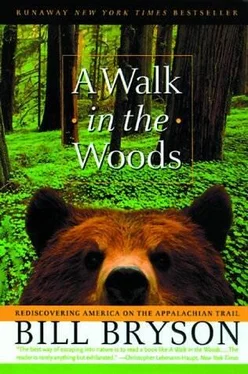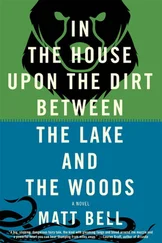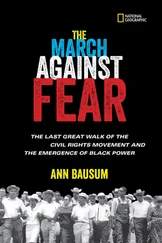Bill Bryson - A Walk In The Woods
Здесь есть возможность читать онлайн «Bill Bryson - A Walk In The Woods» весь текст электронной книги совершенно бесплатно (целиком полную версию без сокращений). В некоторых случаях можно слушать аудио, скачать через торрент в формате fb2 и присутствует краткое содержание. Жанр: Современная проза, на английском языке. Описание произведения, (предисловие) а так же отзывы посетителей доступны на портале библиотеки ЛибКат.
- Название:A Walk In The Woods
- Автор:
- Жанр:
- Год:неизвестен
- ISBN:нет данных
- Рейтинг книги:4 / 5. Голосов: 1
-
Избранное:Добавить в избранное
- Отзывы:
-
Ваша оценка:
- 80
- 1
- 2
- 3
- 4
- 5
A Walk In The Woods: краткое содержание, описание и аннотация
Предлагаем к чтению аннотацию, описание, краткое содержание или предисловие (зависит от того, что написал сам автор книги «A Walk In The Woods»). Если вы не нашли необходимую информацию о книге — напишите в комментариях, мы постараемся отыскать её.
A Walk In The Woods — читать онлайн бесплатно полную книгу (весь текст) целиком
Ниже представлен текст книги, разбитый по страницам. Система сохранения места последней прочитанной страницы, позволяет с удобством читать онлайн бесплатно книгу «A Walk In The Woods», без необходимости каждый раз заново искать на чём Вы остановились. Поставьте закладку, и сможете в любой момент перейти на страницу, на которой закончили чтение.
Интервал:
Закладка:
She told me that the previous year 1,500 prospective thru-hikers had started the trail, 1,200 had made it to Neels Gap (that’s a dropout rate of 20 percent in the first week!), about a third had made it to Harpers Ferry, roughly halfway, and about 300 had reached Katahdin, a higher success rate than usual. Sixty or so people had successfully hiked the trail from north to south. This year’s crop of thru-hikers had been passing through for the past month. It was too early to say what the final figure for the year would be, but it would certainly be higher. It rose, in any case, almost every year.
I asked her about the dangers of the trail, and she told me that in the eight years that she had worked for the ATC, there had been just two confirmed cases of snakebite, neither fatal, and one person killed by lightning.
I asked her about the recent murders.
She gave a sympathetic grimace. “It’s awful. Everyone’s really upset about it, because trust is such a kind of bedrock part Of hiking the AT, you know? I thru-hiked myself in 1987, so I know how much you come to rely on the goodness of strangers. The trail is really all about that, isn’t it? And to have that taken away, well…” Then, remembering her position, she gave me a little bit of the official line-a brief, articulate spiel to the effect that one should never forget that the trail is not insulated from the larger ills of society but that statistically it remains extremely safe compared with most places in America. “It’s had nine murders since 1937-about the same as you would get in many small towns.” This was correct, but a wee disingenuous. The AT had no murders in its first thirty-six years and nine in the past twenty-two. Still, her larger point was inarguable. You are more likely to be murdered in your bed in America than on the AT. Or as an American friend put it to me much later: “Look, if you draw a two thousand-mile-long line across the United States at any angle, it’s going to pass through nine murder victims.”
“If you’re interested, there’s a book about one of the murders,” she said and reached below the counter. She rooted for a moment in a box and brought out a paperback called Eight Bullets, which she passed to me for examination. It was about two hikers who were shot in Pennsylvania in 1988. “We don’t keep it out because, you know, it’s kind of upsetting, especially now,” she said apologetically.
I bought it, and as she handed me my change I mentioned to her the thought that if the women in Shenandoah had survived they would be passing through about now. “Yeah,” she said, “I’d thought about that.”
It was drizzling when I stepped back outside. I went up to Schoolhouse Ridge to have a look at the battlefield. It was a large, parklike hilltop with a wandering path lined at intervals with information boards describing charges and last-ditch stands and other confused, noisy action. The battle for Harpers Ferry was the finest moment for Stonewall Jackson (he who had last come to town to hang John Brown) because it was here, through some deft maneuvering and a bit of luck, that he managed to capture 12,500 Union troops, more American soldiers than would be captured in a single action until Bataan and Corregidor in World War II.
Now Stonewall Jackson is a man worth taking an interest in. Few people in history have achieved greater fame in a shorter period with less useful activity in the brainbox than Gen. Thomas J. Jackson. His idiosyncrasies were legendary. He was hopelessly, but inventively, hypochondriacal. One of his more engaging physiological beliefs was that one arm was bigger than the other, and in consequence he always walked and rode with that arm raised, so that his blood would drain into his body. He was a champion sleeper. More than once he fell asleep at the dinner table with food in his mouth. At the Battle of White Oak Swamp, his lieutenants found it all but impossible to rouse him and lifted him, insensible, on to his horse, where he continued to slumber while shells exploded around him. He took obsessive zeal in recording captured goods and would defend them at all costs. His list of matériel liberated from the Union Army during the 1862 Shenandoah campaign included “six handkerchiefs, two and three quarter dozen neckties, and one bottle of red ink.” He drove his superiors and fellow officers to fury, partly by repeatedly disobeying instructions and partly by his paranoid habit of refusing to divulge his strategies, such as they were, to anyone. One officer under his command was ordered to withdraw from the town of Gordonsville, where he was on the brink of a signal victory, and march on the double to Staunton. Arriving in Staunton, he found fresh orders to go at once to Mount Crawford. There he was told to return to Gordonsville.
It was largely because of his habit of marching troops all over the Shenandoah Valley in an illogical and inexplicable fashion that Jackson earned a reputation among bewildered enemy officers for wiliness. His ineradicable fame rests almost entirely on the fact that he had a couple of small but inspiring victories when elsewhere Southern troops were being slaughtered and routed and by dint of having the best nickname any soldier has ever enjoyed. He was unquestionably brave, but in fact it is altogether possible that he was given that nickname not for gallantry and daring but for standing inert, like a stone wall, when a charge was called for. Gen Barnard Bee, who gave him the name at the First Battle of Manassas, was killed before the day was out, so the matter will remain forever unresolvable.
His victory at Harpers Ferry, the greatest triumph for the Confederacy in the Civil War, was almost entirely because for once he followed the instructions of Robert E. Lee. It sealed his fame. A few months later he was accidentally shot by his own troops at the Battle of chancellorsville and died eight days later. The war was barely half over. He was just thirty-nine.
Jackson spent much of the war in and around the Blue Ridge Mountains, camping in and marching through the very woods and high gaps through which Katz and I had lately passed, so I was interested to see the scene of his greatest triumph, though really I was curious to learn if the developer had done anything up there worth getting indignant about.
In the rain and dying light, I couldn’t see any sign of new houses, certainly not on or near the sacred ground. So I followed the path around the undulating field, reading the information boards with dutiful attention, trying to be absorbed by the fact that Captain Poague’s battery had stood just here and Colonel Grigsby’s troops were arrayed over there, but being considerably less successful than one might hope when one is growing slowly soaked in the process. I didn’t have the necessary energy to imagine the noise and smoke and carnage. Besides, I had had enough death for one day, so I tramped back to the car and pushed on.
Chapter 14
In the morning, I drove to Pennsylvania, thirty miles or so to the north. The Appalachian Trail runs for 230 miles in a northeasterly arc across the state, like the broad end of a slice of pie. I never met a hiker with a good word to say about the trail in Pennsylvania. It is, as someone told a National Geographic reporter in 1987, the place “where boots go to die.” During the last ice age it experienced what geologists call a periglacial climate-a zone at the edge of an ice sheet characterized by frequent freeze-thaw cycles that fractured the rock. The result is mile upon mile of jagged, oddly angled slabs of stone strewn about in wobbly piles known to science as felsenmeer (literally, “sea of rocks”). These require constant attentiveness if you are not to twist an ankle or sprawl on your face-not a pleasant experience with fifty pounds of momentum on your back. Lots of people leave Pennsylvania limping and bruised. The state also has what are reputed to be the meanest rattlesnakes anywhere along the trail, and the most unreliable water sources, particularly in high summer. The really beautiful Appalachian ranges in Pennsylvania -Nittany and Jacks and Tussey-stand to the north and west. For various practical historical reasons, the AT goes nowhere near them. It traverses no notable eminences at all in Pennsylvania, offers no particularly memorable vistas, visits no national parks or forests, and overlooks the state’s considerable history. In consequence, the AT is essentially just the central part of a very long, taxing haul connecting the South and New England. It is little wonder that most people dislike it.
Читать дальшеИнтервал:
Закладка:
Похожие книги на «A Walk In The Woods»
Представляем Вашему вниманию похожие книги на «A Walk In The Woods» списком для выбора. Мы отобрали схожую по названию и смыслу литературу в надежде предоставить читателям больше вариантов отыскать новые, интересные, ещё непрочитанные произведения.
Обсуждение, отзывы о книге «A Walk In The Woods» и просто собственные мнения читателей. Оставьте ваши комментарии, напишите, что Вы думаете о произведении, его смысле или главных героях. Укажите что конкретно понравилось, а что нет, и почему Вы так считаете.












